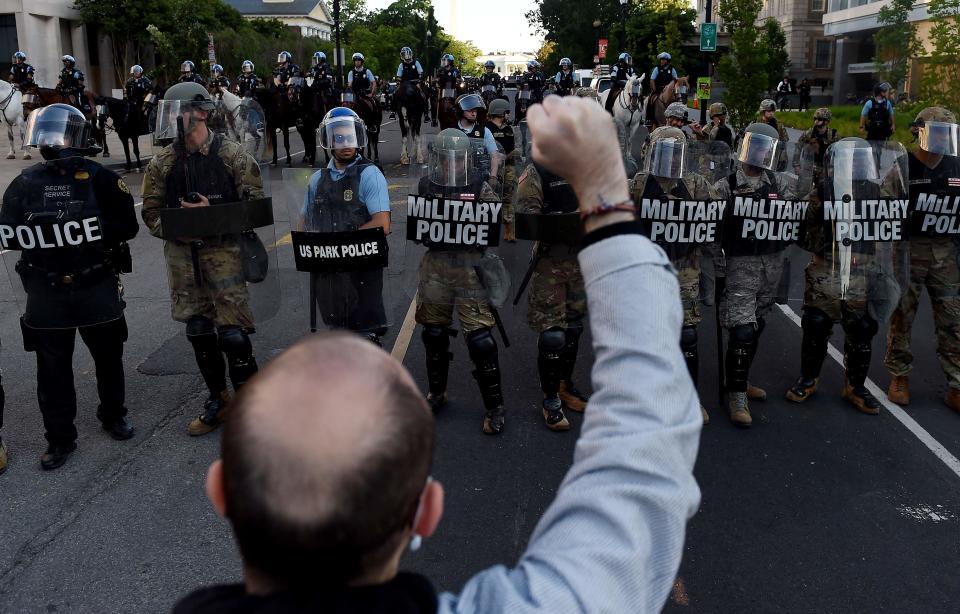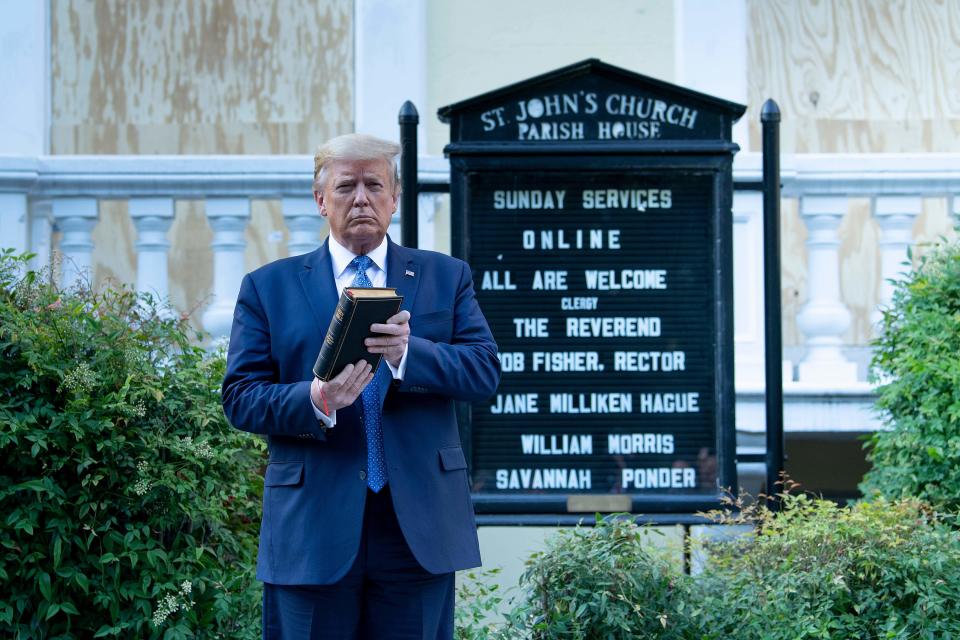'Law and order': Trump returns to 2016 theme as violence spreads after George Floyd death
WASHINGTON – At the Kennedy Space Center over the weekend, President Donald Trump reflected the crises facing his administration: Acknowledging the "pain" felt by millions of Americans, he called for "healing, not hatred."
Forty-eight hours later, as peaceful protesters were cleared from a park near the White House, the president stood in the Rose Garden, described himself as "your president of law and order" and demanded local officials "dominate the streets" – or else.
The whipsaw shift in tone underscored a change of direction from the White House and its conservative allies: The increasingly confrontational demonstrations taking place across the USA, observers said, have given Trump an opportunity to reprise his get-tough approach to law enforcement from the 2016 campaign.
"We’re not going to solve our issues of racial inequality or feelings of economic hopelessness brought on by the coronavirus pandemic overnight, but we can stop the riots and protests with bold, definitive and unapologetic action," said Jason Miller, who served as a senior communication adviser to Trump's 2016 campaign.
The president brandished that message with a high degree of drama and controversy Monday, appearing in the Rose Garden as Secret Service and police swiftly cleared an adjacent park of protesters. Trump then strolled through the park to stand outside historic St. John's Church, which had been vandalized the night before.
On Twitter Tuesday, Trump touted what he said was "overwhelming force" and "domination" of protesters in D.C.
Critics, including some Republicans, described the visit to St. John's church as a "photo-op" and a "stunt" designed to give the president an image of walking through Lafayette Square that was widely shared by his supporters on social media. Though there has been violence and rowdiness in the same park in recent days, reporters observing the events and Washington Mayor Muriel Bowser, a Democrat, said the demonstrations were calm for hours leading up to their abrupt removal.
Sen. Ben Sasse, R-Neb., who occasionally criticizes Trump, slammed the president not only for clearing the park but also holding up a Bible when he arrived at St. John's Episcopal Church near the White House.
"There is no right to riot, no right to destroy others’ property and no right to throw rocks at police," Sasse said. "But there is a fundamental – a constitutional – right to protest, and I’m against clearing out a peaceful protest for a photo op that treats the Word of God as a political prop."
Sasse was not alone in that assessment.
"Anybody that protests something like that peacefully should not be impeded either," said Sen. Mike Braun, R-Ind. "So that it's a tough call because you're in the moment and it all gets a little blurry but we got to do better at that."

Many Trump supporters viewed the walk across Lafayette Square as a moment of strength and a demonstration of the president's resolve to end the violence ripping through American cities. They questioned media coverage of the park's clearing and, in particular, reporting that tear gas was deployed.
The U.S. Park Police said in a statement Tuesday that its officers issued three warnings over a loudspeaker to alert demonstrators to evacuate the area. As many of the protestors became more combative, continued to throw projectiles and attempted to grab officers’ weapons, the statement said, officers used smoke canisters and pepper balls. No tear gas was used by the Park Police or other law enforcement to close the area around Lafayette Park, the agency said.
Trump's walk to St. John's, which was damaged by fire a day earlier as protests turned violent, followed reports that he had been hurried into an underground bunker at the White House as protests built Friday – an episode that drew a storm of criticism. Trump, who frequently describes his political opponents as "weak" and who uses the 1978 song "Macho Man" in the playlist at campaign and official events, wanted to pay his respects to the church but also wanted to leave the White House to prove he was not "in the bunker," said one official who requested anonymity to discuss the president’s strategy.
Trump's display drew fierce criticism from Democrats, who noted that at the exact moment the president was describing himself as an "ally" of peaceful protesters, military police were clearing a park of protesters who were demonstrating without incident.
The criticism did not deter Trump from visiting a Catholic shrine across town Tuesday, a trip that was slammed by a top church official, Washington Archbishop Wilton D. Gregory.
“I find it baffling that and reprehensible that any Catholic facility would allow itself to be so egregiously misused and manipulated in a fashion that violates our religious principles, which call us to defend the rights of all people even those with whom we might disagree,” Gregory said in a statement.
In 2016, Trump repeatedly described himself as "the law and order candidate" as the nation was wrestling with many of the same questions about police use of force and the targeting of African Americans as it is now.
"We must maintain law and order at the highest level, or we will cease to have a country," Trump said in the summer of 2016 during an address in Virginia.
The president returned to that message in a call with governors Monday, calling them "weak" and arguing they needed to "dominate" the "radicals" and "anarchists" he said were behind the violence. Using blunt language, Trump urged the governors to crack down hard on violent protests in dozens of cities.

In another example of that more aggressive messaging, White House officials said this week that the president was considering invoking an 1807 federal law that would allow him to deploy active-duty U.S. troops to respond to protests in cities. Known as the Insurrection Act, it was last used in 1992 in response to the Rodney King riots in Los Angeles.
Though Trump's core supporters may embrace the more combative approach, outside observers noted that it carries risk. Federal and state officials traditionally seek to lower the temperature when unrest breaks out, not raise it. It's possible Trump's remarks could escalate the demonstrations. Washington officials reported more than 300 arrests Monday, most for curfew violations.
Trump has largely side-stepped the protests' underlying issues. He said the nation is "sickened and revolted" by the death of George Floyd, an unarmed black man who died in police custody in Minneapolis – and he promised justice for Floyd's family – but he stopped short of addressing the systemic concerns of racism and disparate use of force that sparked the anger.

"You have an upset nation," said James Williams, 49, an African American who attended the demonstration Monday at Lafayette Square, along with his wife and 14-year-old son. Williams, an engineer from suburban Virginia – a battleground area in the presidential election – also participated in Sunday's protest.
"I came to see how everyone else feels about the injustice that is being done to African American people," Williams said, adding that the country's law enforcement system is "not the same for African Americans as it is for white Americans."
Democratic strategist Jim Manley said he was not convinced that running on a platform of law and order was necessarily going to help Trump much. "His base will love it, but given his propensity to overreach, he will just turn off the swing voters in the suburbs."
Matt Mackowiak, a GOP political consultant, was one of several Republicans who suggested Trump could bind the nation's wounds with a formal address, perhaps from the Oval Office. Mackowiak spoke with USA TODAY before the president's remarks Monday.
"I believe a national address would be helpful if the president spoke to the intense anger over the senseless Floyd killing and urged calm and nonviolent protest," he said. "I believe the silent majority sympathizes with anger over the Floyd killing while they are also horrified at the rioting and looting."
Some Republican lawmakers sharpened their criticism of the president's tone during the unrest. Sen. Pat Toomey, R-Pa., said some of Trump's "tweets have not been helpful." Sen. Susan Collins, R-Maine, who faces a tough reelection, said the president should highlight "the fact that we need to work on the underlying racial injustice in this country, but we need to do so in a peaceful manner."
Administration officials indicated Monday that Trump believes he has spoken sufficiently on the topic and that his goal would be to take actions to promote security. That approach is more in Trump's wheelhouse: setting up fights not only with those protesters who are causing trouble but also Democratic mayors in the besieged cities.
Through the highs and lows of his presidency, Trump's polling has remained consistent – underscoring a conventional wisdom that most Americans have made up their mind about him. It's not clear that Trump could "heal" a highly polarized nation, several observers said, even if he wanted to.
"This is heartbreaking. The divide in our homes and among our friends is now on the streets," veteran GOP consultant Frank Luntz told USA TODAY before Trump's visit to St. John's. "But politically, I understand why he's remained quiet. The people he needs to address don't want to hear him, and his base is appalled at the looting."
The unrest and angst, much of it driven by racial tension, has prompted comparisons to 1968, when Richard Nixon ran for president in part on a "law and order" platform after race riots prompted by the assassination of Martin Luther King Jr. Matt Dallek, a political historian at George Washington University who has studied social crises, said the comparison to the 1960s works only to a point.
Americans, he noted, were also angry with President Lyndon Johnson's handling of Vietnam.
"I do think there’s an interesting echo in that Lyndon Johnson was in many ways the author of his own defeat," Dallek said.
But Johnson had already removed himself from the race in 1968. And Trump, Dallek said, has already run a campaign focused on law and order.
"What (Trump) really promised was a restoration of order, and what we've seen is really the opposite," Dallek said. "In many ways, he's inflamed an already bad situation."
Contributing: Caren Bohan, Christal Hayes, Nicholas Wu
This article originally appeared on USA TODAY: George Floyd: Trump returns to 'law and order' theme in Rose Garden

